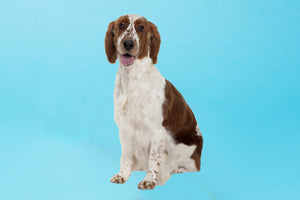
FREE UK DELIVERY ON ORDERS OVER £39.99

Pugs have become incredibly popular over the last few decades but they have actually been around for many centuries. They feature in a wide range of memes and social media campaigns and are especially popular among younger owners.
Breed History
Pugs are thought to be an ancient breed owned by Chinese emperors and are thought to have been originally known as the lo-chiang-sze, or the foo dog. It is thought they were brought over to Europe in the 16th Century and were cherished lapdogs of numerous monarchs, including the House of Orange.
General Appearance
The pug is a small sized breed with a barrel shaped body and short legs. Known for their flattened faces (brachycephalic breed), the pug is a sturdy breed whose chest size increases greatly with age.
Temperament
Due to their original role of lapdog for royals and emperors, Pugs are known to be sensitive and affectionate towards their humans albeit with a slight stubborn side. They are fairly easy going and can make great companion pets. Pugs do not appreciate being left alone for long periods of time and are quite sensitive, especially if they feel they are not the centre of attention!
Health Considerations
Sadly, the Pug is an unhealthy breed. They suffer from a range of health conditions thanks to their genetics and conformation. They can struggle with their breathing and many have chronic skin disease. Breed members also suffer with conditions including Dry Eye, Epilepsy, Intervertebral Disc Disease and Periodontal Disease. In Holland, there is a breeding scheme which bans breeding those with snouts that are too short. Pugs are prone to dental issues as they often have dental crowding. There are several things you can do to prevent periodontal disease in this breed. Feeding hard kibble is advised and many do well on the Pooch & Mutt Adult Superfood. You should also aim to brush your pugs teeth daily.
Trainability
Whilst Pugs may not be the easiest of breeds to train, it is definitely possible with some perseverance and a whole lot of positive reinforcement. Why not try including Pooch & Mutt Mini-Bone treats into your training routine, at just 2-3 calories per treat, you don’t need to worry about your Pug piling on the pounds every time they learn a new trick.
Grooming
Unlike many breeds, Pugs seem to actually enjoy being gently groomed. This may have something to do with their history as a lapdog, living a life of luxury with their royal human counterparts. You should aim to bathe your Pug at least once a month and ensure you are cleaning their wrinkles and eye area daily. You will also need to clean your Pugs ears every few weeks.
Exercise
Pugs are a relatively low maintenance breed when it comes to exercise. You should aim for at least 40 minutes of walking a day split into 2 - 3 shorter walks to ensure their breathing is not affected. Mixing shorter walks with at-home play for mental and physical stimulation is recommended.
Feeding Considerations
As Pugs can be prone to dental problems, feeding them kibble over wet food from a young age is advised. There are also plenty of dental chews available that can help your Pug from a relatively young age.
You'll find a handy feeding calculator on every product page here at Pooch & Mutt to help you identify how much of our health led recipes are right for the age, size and weight of your dog.
Comments (0)
Leave a comment